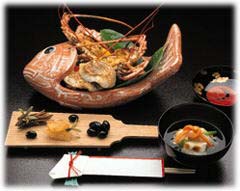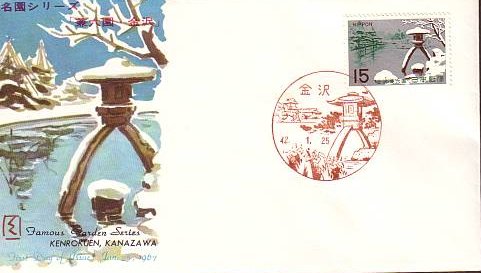
Japan in January
January 1: New Year's Day
This is one of the biggest events of the entire year. Schools close for about two weeks for winter holiday before and after New Year's and most companies also shut down from around December 30 to January 3.
Starting even before dawn people flock to shrines and temples to pray for a health and happy year. This is called hatsu-mode and is one of the most important rituals of the entire year. When you greet someone then you say "akemashite omedeto gozaimasu" which basically means "a happy new year".
Special meals called oeschi ryori are prepared the last day or so of December and are eaten during the first three days of January. They consist of boiled beans, broiled fish and sliced vegetables and seafood dressed with sweet vinegar. The meals are put into boxes for easy storage.
Other foods eaten include toso, which is a spiced rice wine and kazunoko, which is salted herring roe.

Nengajo are New Year greeting cards that people receive at this time. The post office posts a deadline and if you meet that they guarantee they will deliver the nengajo on New Year's Day.
Children at this time will receive otoshidama which is a money gift from parents, relatives and other adults.
The first dream of the New Year (generally on January 2nd since people often stay up all day New Year's Day) is regarded as an omen about how the rest of the year will go. The belief goes back at least as far as the fourth century because a historical document refers to a this type of dream by Emperor Suinin.
The three best dreams you can have, in order, are about Mount Fuji, hawks and eggplants. Mount Fuji is the tallest mountain in Japan and is considered sacred. Hawks refer to another mountain called Ashitaka that is about half as tall as Mount Fuji. The eggplants, oddly enough, were added to the list to poke fun at high prices in ancient Japan.
On this date also in the Imperial Palace the Emperor performs the rite of shihohai, or worship of the four quarters. On January 2nd the public is allowed to enter the inner palace grounds, one of only two times during the entire year that this is allowed.
At the Yashiro-jjinja Shrine, Toba-shi, Mie on this day young men will thrust bamboo poles into a large white wheel called an awa and parade it aloft.
January 6: Dezomeshiki
On this day in Tokyo fireman perform acrobats on bamboo ladders to impress the public.
January 7: The 7 Herbs of Spring
On this day families prepare kayu cooked with seven different vegetables referred to as the haru no nanakusa, or the seven herbs of spring. Kayu itself is a porridge made by cooking rice with twice the usual amount of water.
The practice came to Japan from China and goes back at least a thousand years.
The exact herbs referred to will vary from region to region but in general consist of leaves of dropwort, shepherd's purse, cottonweed, chickweed, hentit, turnip and radish.
Eating the greens is thought to replenish the body with energy from nature and to encourage good health and long life.
January 9-11: Toka Ebisu Festival
This festival is held in Osaka to pray for prosperity in business and takes place in three parts. You Ebisu is on the 9th, Hon Ebisu is on the 10th, and Nokorifuku is on the 11th.
During the festival they will be a parade of kago (papanquins) bearing geisha on them. People at the festival will receive lucky decorations made of sasa bamboo grass) leaves.
January 11: Mochi
Another special food for this time of year is mochi which is made by steaming and pounding a sticky type of rice. During the holidays a pair of round mochi, the size of plates, is made and stacked on a stand and placed in a household Shinto altar as an offering to the deities. It is removed on January 11 and broken into smaller pieces and then eaten. People thus believe they were inviting the blessings of the gods by eating the food that was in the altar.
The custom was originated by the samurai class.
January 14
On this day the pine tree decorations at the doors of the household are removed (although it some places it has been moved up to January 7).
January 14: Komedawara-hiki
This somewhat unusual celebration (Aizubange-machi, Fukushima) features semi-naked young men wrestling for a large rice bale. Supposedly the outcome will foretell the price of rice for the coming year.
Early January: Parade of fire brigades
The various fire brigades in the communities put on a display of their skills in a parade called a dezome-shiki, another tradition which goes back centuries. In Tokyo alone some 5,000 firefighters participate in the parade. There can be more than 200 trucks and 5 helicopters in that parade alone.
A special part of this celebration is a demonstration of the use of fire ladders in acrobatic maneuvers. This originated in the Edo period, 1603-1868.
January 15: Adult's Day
On this day people who have reached 20 years of age are honored and officially accepted as adults. They attend a formal ceremony held at the local government office where each young adult officially accepts responsibility as a citizen. Pictures of the event are often sent to relatives. Sometimes families will give their new adult a gift of money; daughters are sometimes given a traditional kimono.
January 15 is also called Small New Year and gruel cooked with red beans is eaten to drive away evil spirits and illness for the coming year.
January 15: Wakakusayama Yaki Festival
The Wakakusayama Yaki Festival is held at night near the city of Nara. Fireworks are set off and priests from two temples set light to the dry grass on the slopes of Mt. Wakakusa to the eat of the city.
January 15: Chakkirako
An children's festival in which an ancient dance is performed by young girls dresses in their best kimonos.
January 18
On this date the annual outakai-hajime or poetry party is held at court with poems on a selected theme and submitted by the public are read aloud.
January 25: Hanazoke Katsugi
Sankawa-temmangu Shrine, Oyamashi, Tochigi. Young girls carrying wooden tubs holding magical flowers to ward off evil parade to the shrine.

|